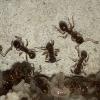I have a colony Forelius sp. with ~200 workers, 1 queen, and 300-400 pieces of brood. These Forelius are dissimilar enough to Forelius pruinosus and Forelius mccooki that I suspect they should be their own seperate species of Forelius. For one, all of the colonies I have ever excavated have been monogynous. Secondly, they are much more cryptic than F. pruinosus and F. mccooki. The colonies in the wild typically contain somewhere in the neighborhood of 1,000-2,000 workers. Sometimes they will be polydomous, other times they aren't. They have a very weird activity cycle, and most of the times won't even forage unless the ground temperature is in excess of 85-90F. Even if the ground temperatures are that high, it seems that oftentimes the colonies are just like "I don't feel like foraging today, lol". The queen of this colony is also quite physogastric. In the wild, when I collected her, she looked like a termite queen ![]() . This may just be because of the incredibly polygyny that is typically found in US Forelius spp. but I have yet to see a US Forelius spp. queen that has gotten so physogastric. The other huge indicator here is the isolation of the Forelius sp. population. They only do good in soils that have a high sand content and in areas with a low amount of vegetation. As you can imagine, that's not much of the Midwest. So the populations I find in different areas are likely isolated and have been for quite some time. This is one of the indicators biologists look for when throwing around the idea of a new species. Their unique bi-coloration is also quite unusual for Forelius specimens, but that doesn't necessarily mean they are a separate species.
. This may just be because of the incredibly polygyny that is typically found in US Forelius spp. but I have yet to see a US Forelius spp. queen that has gotten so physogastric. The other huge indicator here is the isolation of the Forelius sp. population. They only do good in soils that have a high sand content and in areas with a low amount of vegetation. As you can imagine, that's not much of the Midwest. So the populations I find in different areas are likely isolated and have been for quite some time. This is one of the indicators biologists look for when throwing around the idea of a new species. Their unique bi-coloration is also quite unusual for Forelius specimens, but that doesn't necessarily mean they are a separate species.
I'm going to be keeping a journal of this colony here to document their behaviors and progress as a colony. So far, they have around ~200 larvae, some are in pre-molt, a single alate pupae, and roughly 100 eggs that have been laid by the queen in my care. Considering that the queen is continuing to swell, and I keep the colony at 100F+, I expect to see her laying significantly more eggs as well as incredible egg-to-worker development times.
Here is a video of them:
At 40 seconds you can witness a worker laying an egg and then feeding it to the queen. Just thought that was neat, since it's not commonly captured on video.
Let me know if you guys think this should indeed be a separate species of Forelius spp. or if you think the discrepancies I'm noticing are just a-typical intraspecies variation. ![]()
Edited by Mdrogun, June 14 2020 - 2:03 PM.















